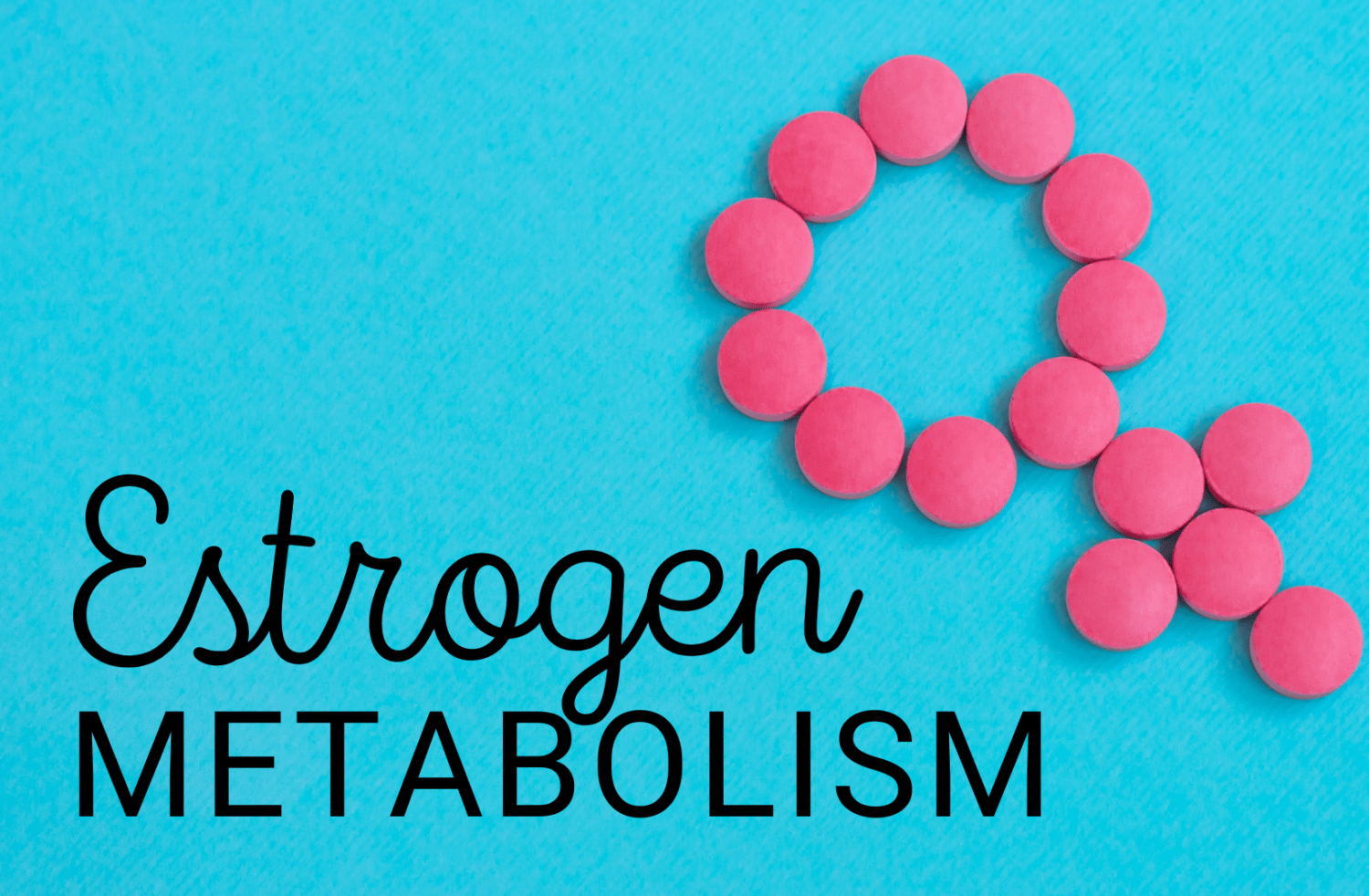UNDERSTANDING YOUR ESTROGEN METABOLISM IS IMPORTANT
Many women in their 40’s experience estrogen dominance due to progesterone deficiency (low progesterone). It’s becoming more common to see estrogen dominance that’s exacerbated by poor estrogen clearance, thyroid disease, xenoestrogen exposure, stress, hormonal birth control, and poor gut health. This is why I address these underlying issues of estrogen dominance in The Female Energy Equation, and in the 10-Day Energy Reset & Detox Programs.
Supporting gut health and detoxification pathways are critical to clearing out toxic estrogens and improving estrogen/progesterone balance. When my clients & students address these areas of health, symptoms of estrogen dominance improve greatly.
If you’re a 40-something woman experiencing symptoms like fatigue, mood swings, heavy periods, breast swelling/tenderness, fibrocystic breasts, uterine fibroids, endometriosis, gallbladder disease, weight gain, PMS, migraines, or painful periods, you might be experiencing estrogen dominance.
Estrogen dominance can impact energy levels, blood sugar metabolism, fat accumulation and loss, and neurotransmitter production as well, leading to anxiety and depression. It can also put you at higher risk of thyroid dysfunction, breast cancer, and autoimmune disease.
Your doctor won’t test your estrogen metabolism because there aren’t any appropriate medical treatments outside of chemical or surgical menopause. Most women are not interested in the side effects that come with these treatments. Most often a visit to the doctor complaining of any of the above might land you a prescription for antidepressants and an admonition to lose weight by eating less and exercising more. I know, I’ve been there.
This is why DUTCH testing has become my secret weapon in helping my clients discover exactly what is going on with their hormones at 40 and beyond, including their estrogen metabolism. To find out more about DUTCH Hormone Testing, go here.
Understanding how the body metabolizes and detoxifies estrogens can illuminate many of the underlying challenges that are causing estrogen dominance. Every woman’s estrogen metabolism is different, so the balance between your “good” and “bad” pathways is unique. The DUTCH Test can show you your unique estrogen metabolism status.
In this article, I’ll share the details of how estrogen metabolism and detox so you can see why nutrition and lifestyle support are critical to overcoming estrogen dominance. You’ll see that your liver and your gut are key players in this process. You’ll be armed with the information you need to begin your journey to better hormone balance.
Your liver performs at least 500 functions, including those related to digestion. The human liver is about the size of a football and is located just under the right rib cage in the upper abdomen. It is integral to digestion, metabolism, nutrient storage, blood products, clotting factors, and immune function. Whew!
The liver processes blood after it passes through the stomach and intestines. It breaks down, balances, and creates the nutrients into forms that are easier for the rest of the body to use. It also transforms toxic substances like chemicals, hormones, and medications into nontoxic substances to be excreted from the body.
The liver’s job of preparing toxic substances for excretion is even more vital in the US, where women are exposed to more toxins than ever. Between cosmetics, perfumes, personal care products and feminine hygiene products, women in the US apply an average of 168 chemicals to their faces and bodies every day, according to the Environmental Working Group. Add to that the liver’s job of detoxifying estrogens, and the liver can get overwhelmed pretty quickly.
Detoxification requires some important enzymes known as cytochrome P450 enzymes. These enzymes are heme-dependent proteins that play a pivotal role in the detoxing of medications, hormones, xenobiotics, and products of cellular metabolism. These enzymes are required to convert used estrogens to inactive metabolites for elimination. This process is known as estrogen metabolism. Hormones must be processed and eliminated in the same way as chemicals and medications, or else we risk toxicity.
Detoxification in the body has 3 stages…
- PHASE I: Bioactivation– Creation of water-soluble intermediary metabolites
- PHASE 2: Conjugation– The neutralization of water-soluble intermediaries
- PHASE 3: Transportation & Excretion– Elimination of neutralized intermediaries
Phase 1 metabolism of estrogens mainly occurs in the liver where CYP enzymes are most abundant, but also occurs outside of the liver in tissues they target. Phase 2 metabolism of estrogens requires COMT enzymes. Genetic changes in the genes that create these enzymes can also influence estrogen metabolism negatively, which is why I frequently use genetic testing to help my clients optimize their estrogen metabolism.
PHASE 1: BIOACTIVATION
- THE GOOD: 2-hydroxyestradiol (2-OH): This metabolite is a very weak form of estrogen, often referred to as the “good” estrogen. CYP1A2 and CYP3A4 convert estradiol to 2-OH in the liver, and CYP1A1 converts it outside of the liver. Clearing lots of estrogen down this pathway is a good thing!
- THE BAD: 16-hydroxyestrdiol (16-OH): The 16-OH metabolite is a potent form of estrogen known to be growth promoting. It is often referred to as the “bad” estrogen. Too much 16-OH can promote cancers. CYP3A4 converts estradiol into 16-OH. Clearing lots of estrogen down this pathway is a bad thing.
- THE UGLY: 4-hydroxyestradiol (4-OH): The 4-OH metabolite generates free radicals promoting quinone forms, which cause cellular damage that promotes breast and endometrial cancer. This form of estrogen can damage DNA. CYP1B1, which is highly expressed in estrogen target tissues, (breast, ovary, and uterus) converts estradiol to 4-OH. Clearing lots of estrogen down this pathway is bad and put you at high risk of cancer.
The Phase 1 estrogen metabolites are considered to be free radicals. These metabolites are meant to continue through the detoxification process to be inactivated and eliminated. In Phase I of detoxification, estrogen metabolites are converted by the CYP enzymes as follows…
PHASE 2: CONJUGATION
In the second phase of estrogen detoxification, the estrogen metabolites undergo methylation to neutralize them and prepare them for excretion in Phase 3 of the detox process. The neutralization of these metabolites makes them safer and ready for excretion by the body. 2-OH, 4-OH, 16-OH undergo this process when the COMT enzyme transforms them by adding a methyl group taking them from toxic and potentially carcinogenic to a neutralized form. If 4-OH is not neutralized in this process, glutathione, a potent antioxidant, will be required to neutralize it.
PHASE 3: TRANSPORTATION & EXCRETION
In this phase, water-soluble estrogens are transported out of the cell via cellular transport proteins. These deactivated estrogens are transported into urine and bile then excreted via urine or stool. There are dietary and microbiome factors the affect elimination, as well as bowel habits. Frequency of elimination is also a critical factor in detoxification of estrogens and other toxins.
This last step is getting much more attention these days, as poor gut health plays a role. Poor gut health can cause deactivated estrogens to be reactivated and recirculated, promoting further estrogen exposure.
As you can see, the process of estrogen metabolism and detoxification is a multi-step, nutrient and enzyme dependent process meant to protect you from estrogen dominance and its symptoms.
ESTROGEN DOMINANCE: COMMON FOR A WOMAN IN HER 40’S
If you’ve been paying attention, or you’ve read my article about estrogen dominance, you may have discovered that you, or someone you know may be suffering from this condition that commonly afflicts women in their 40’s.
Estrogen dominance is caused by an imbalance of estrogen and progesterone, where the ratio of estrogen to progesterone is high. It isn’t the only hormone imbalance that women can experience, but due to nutritional, environmental, genetic, and lifestyle factors, it is a common problem for women in the perimenopausal years (late 30’s to early 50’s).
ESTROGEN DOMINANCE HORMONE PROFILES
Let’s talk about the hormone profile of Estrogen Dominance…
Normal Estrogen/Low Progesterone: As you enter your late 30’s and early 40’s progesterone begins to naturally wane. This is due to the slow decline in ovarian function, along with reducing egg quality. As you might recall, when ovulation occurs, the follicle that releases the egg become the corpus luteum which produces progesterone in the second half of the cycle to prepare the uterine lining for pregnancy. The changes caused by declining function of the ovaries and egg quality reduces progesterone levels, leaving estrogen unopposed. Estrogen usually starts waning at this time, but at a slower rate, so lab tests frequently show estrogen levels are normal while progesterone is low. This makes estrogen “dominant” leading to symptoms of estrogen dominance.
Elevated Estrogen/Normal Progesterone:
For some women, progesterone may remain strong into their early 40’s, but problems arise when estrogen is elevated. This can occur when estrogen clearance is poor, conditions like endometriosis, thyroid disease, obesity can all lead to elevated circulating estrogen, and while progesterone remains normal, the ratio is off balance and symptoms of estrogen dominance start to show up!
If you’re having symptoms of estrogen dominance, it’s time to check your estrogen metabolism. You can get started here. Much can be done to restore balance and overcome the symptoms you’re experiencing. With the right information and support, you can master this critical challenge of mid-life.
If you are ready for in-depth help and support, I invite you to set up a strategy call with me here to find out how you can work with me privately.


